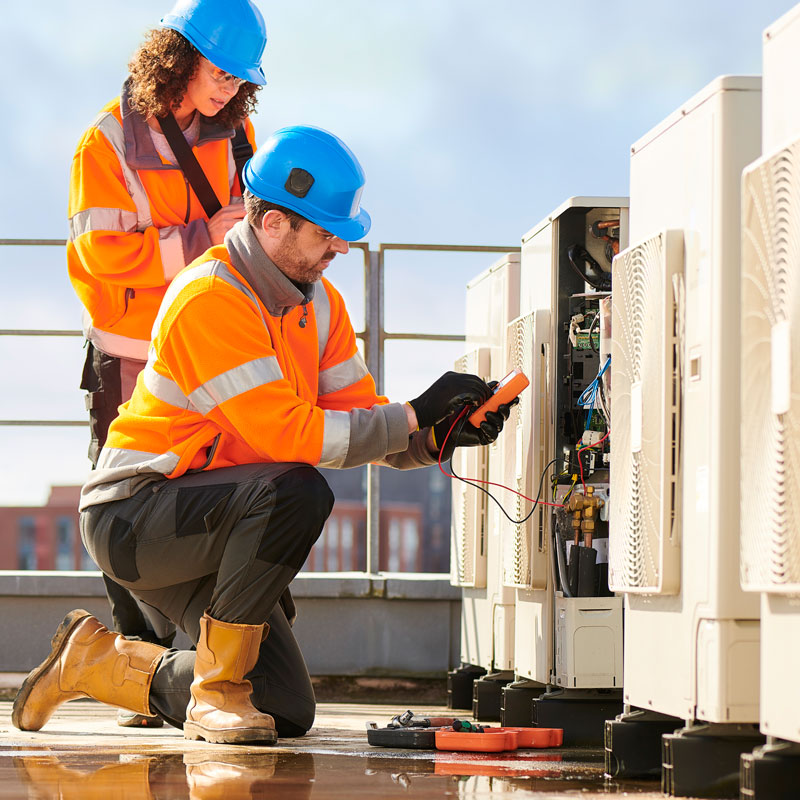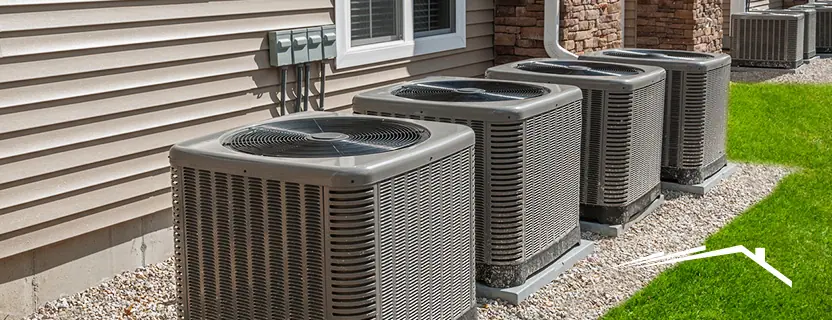Your Ultimate Checklist for Effective heat pump service
Your Ultimate Checklist for Effective heat pump service
Blog Article
How a Heatpump and Furnace Collaborate to Maximize Your Home's Heating Efficiency
Understanding exactly how a warmth pump and heating system interact is vital for property owners looking for effective heating remedies. Each system has its toughness, offering a balanced approach to home convenience. The heatpump excels in moderate temperatures, while the heating system provides quick heat throughout severe cold. This harmony not just minimizes power prices but likewise boosts the lifespan of both devices. What aspects influence this partnership, and how can homeowners maximize their advantages?
Comprehending Heat Pumps: How They Function
Lots of individuals may be unfamiliar with their internal workings, warmth pumps play a vital duty in modern home heating systems. These tools run by transferring warmth from one location to another, utilizing the concepts of thermodynamics. In colder months, a heatpump removes warm from the outdoors air, ground, or water, and transfers it inside to heat the space. On the other hand, throughout warmer months, it can reverse the procedure, acting as an a/c unit by eliminating heat from inside to the outside.Heat pumps are composed of an evaporator, development, compressor, and condenser shutoff. The refrigerant within the system takes in warmth as it vaporizes at low temperature levels and stress. The compressor after that raises the pressure and temperature level of the refrigerant, enabling it to launch heat as it condenses. This efficient process can greatly lower power consumption compared to standard heating methods, making warmth pumps a sustainable selection for environment control in homes.
The Function of Heaters in Home Home Heating
Heating systems play a crucial role in home heating by giving a dependable source of heat throughout the cooler months. They operate by producing heat through combustion or electric resistance, dispersing it throughout the home through ducts or glowing systems. The efficiency of a furnace is usually gauged by its Annual Fuel Usage Efficiency (AFUE) score, which suggests how efficiently the device transforms fuel right into heat.Furnaces can make use of different energy resources, including gas, propane, oil, or electrical energy, allowing house owners to choose the most appropriate option for their requirements. Unlike heatpump, which may struggle in extreme cold, furnaces maintain consistent performance, guaranteeing that indoor temperature levels stay comfortable no matter exterior conditions. In addition, modern furnaces commonly come outfitted with innovative innovation, such as smart thermostats and variable-speed blowers, enhancing their effectiveness and responsiveness. This adaptability makes furnaces a vital element in all-encompassing home heating methods.

Advantages of Using Both Systems Together
Incorporating the staminas of both heaters and heatpump can result in a more effective and reliable home heating service. Making use of both systems allows property owners to make the most of the heatpump's energy efficiency during milder temperature levels while relying upon the heater for even more severe cold conditions. This dual technique can significantly minimize power expenses, as warmth pumps take in less electrical power than traditional heating techniques when temperatures are moderate.Additionally, utilizing both systems with each other can improve comfort levels in the home. Heat pumps can provide regular, even heating, while heaters can promptly elevate ambient temperature levels when needed. The combination of both systems can extend the life expectancy of devices by reducing wear and tear on each unit, as they share the workload. Inevitably, house owners can take pleasure in a balanced, affordable heating option that adjusts flawlessly to varying climate condition, making certain a warm and welcoming home throughout the winter months.
How Warm Pumps and Furnaces Complement Each Various Other
When property owners integrate warm pumps and heating systems, they produce a complementary furnace that maximizes effectiveness and comfort. Heat pumps run by transferring heat from the outdoors air or ground, making them highly efficient in modest environments. They excel throughout milder temperature levels, giving affordable heating. Alternatively, heaters generate warm through combustion or electric resistance, supplying solid, immediate heat during extreme chilly conditions.The combination of these two systems enables dynamic changes based upon temperature fluctuations. Throughout warmer months or milder wintertime days, the heatpump can take the lead, conserving energy and reducing prices. As temperature levels drop, the heating system can perfectly engage, guaranteeing regular warmth throughout the home. This harmony not just optimizes energy usage but also improves the life expectancy of both systems, as each device runs within its ideal efficiency array. With each other, they create a well balanced atmosphere go right here that adapts to differing climate needs.
Maximizing Performance: Tips for Homeowners
Homeowners can improve their heating efficiency through several useful approaches. Establishing a routine upkeep timetable, incorporating smart thermostat modern technology, and applying efficient insulation and securing solutions are crucial actions. These steps not only improve convenience yet also minimize energy prices.
Normal Maintenance Set Up
To assure maximum home heating efficiency, establishing a normal upkeep routine is important for any home. Homeowners should prioritize regular inspections of both heat pumps and heaters to establish peak performance. This consists of changing air filters every one to three months, as blocked filters can substantially reduce effectiveness. Additionally, organizing expert maintenance a minimum of annually allows technicians to identify and address potential problems before they intensify. Homeowners must additionally cleanse the heatpump's exterior device to stop debris buildup that can impede air movement. By sticking to a normal maintenance routine, house owners not only enhance their heater' efficiency however additionally prolong their lifespan, resulting in higher convenience and decreased energy expenses throughout the colder months.
Smart Thermostat Assimilation
Incorporating a smart thermostat into a home heating unit can substantially enhance power effectiveness, especially as it allows for exact control over temperature level setups. These gadgets can learn the house owner's routine and preferences, instantly adjusting the temperature level to enhance convenience while minimizing energy usage. They can decrease home heating during times when the home is unoccupied, lowering unnecessary usage. Many wise thermostats likewise offer real-time power usage information, enabling house owners to make informed choices about their heating habits. In addition, remote accessibility via mobile phone apps enables individuals to adjust setups from anywhere, making certain the home is cozy upon return. Generally, smart thermostat integration not only boosts comfort but significantly adds to power financial savings and performance.
Insulation and Sealing Solutions
Smart thermostats play an essential function in energy efficiency, but their effectiveness can be significantly boosted by proper insulation and sealing solutions. Home owners must focus on protecting floors, walls, and attics to decrease heat loss. High-grade insulation materials, such as spray foam or fiberglass, can greatly enhance thermal resistance. Additionally, securing gaps around ducts, home windows, and doors stops chilly air seepage and warmth getaway. Weatherstripping and caulking are effective approaches for attending to these leakages - heat pump replacement ooltewah tn. Normal evaluations for air leaks, in addition to the use of blower door examinations, can help recognize trouble locations. By spending in insulation and securing, house owners can enhance the efficiency of their home heating systems, ultimately causing minimized energy consumption and lower utility bills
Typical Misconceptions Regarding Warmth Pumps and Furnaces
What false impressions surround heatpump and heaters? Lots of people incorrectly believe that heatpump are inefficient in cooler climates. Actually, modern-day heatpump are designed to run efficiently even in low temperatures, providing trusted heating throughout winter. One more typical myth is that heating systems are constantly a lot more efficient than heatpump. This find more depends on the particular power resources and efficiency rankings of the units in inquiry. Some may also think that making use of both systems concurrently is unnecessary, yet as a matter of fact, this combination can maximize heating effectiveness, especially throughout extreme climate condition. In addition, individuals usually presume that heatpump need constant upkeep, when actually, they have comparable upkeep needs to standard furnace. By exposing these misconceptions, house owners can make even more enlightened choices concerning their home heating choices, inevitably leading to improved comfort and energy effectiveness in their homes.
Upkeep Considerations for Combined Solutions

Often Asked Questions
Can Warm Pumps Work Successfully in Extremely Cold Climates?
Heatpump can have a hard time in incredibly cool climates due to decreased effectiveness and warm removal limitations. Developments in innovation have actually led to models made for better efficiency in such conditions, improving their viability in rough atmospheres.
Exactly How Lengthy Do Heat Pumps and Furnaces Usually Last?
Heatpump generally last 15 to twenty years, while heaters have a life expectancy of 15 to thirty years. Normal maintenance can expand their durability, making sure reliable operation and minimizing the demand for early replacements.

What Is the Typical Price of Putting Up Both Systems?
The ordinary expense of setting up both a heat pump and a heater commonly ranges between $5,000 to $10,000 - heat pump service. Aspects influencing this cost consist of system size, installment intricacy, and local labor prices
Are There Tax Motivations for Utilizing Energy-Efficient Heating Solutions?
Several house owners ask about tax motivations for energy-efficient heating unit. Various federal and state programs often supply discounts or credit ratings, motivating the adoption of lasting modern technologies to decrease energy intake and promote environmental responsibility.
Exactly how Do I Choose the Right Dimension Warm Pump and Heater?
Picking the best size heatpump and furnace entails calculating the home's square video footage, considering insulation top quality, and assessing local environment. Consulting an expert can ensure suitable system efficiency and power efficiency based upon particular needs. ductless mini splits. Recognizing how a heat pump and furnace job with each other is necessary for house owners seeking effective home heating services. In cooler months, a heat pump extracts warm from the outside air, ground, or water, and transfers it inside your home to warm up the living area. When property owners integrate heat pumps and furnaces, they create a complementary home heating system that makes best use of efficiency and comfort. Heat pumps operate by transferring heat from the outside air or ground, making them highly reliable in moderate environments. Warm pumps can struggle in exceptionally cold environments due to reduced effectiveness and heat extraction limitations
Report this page